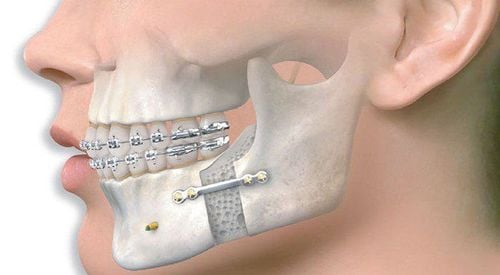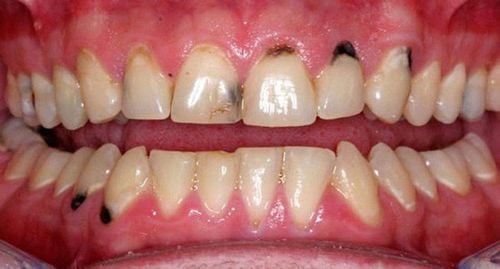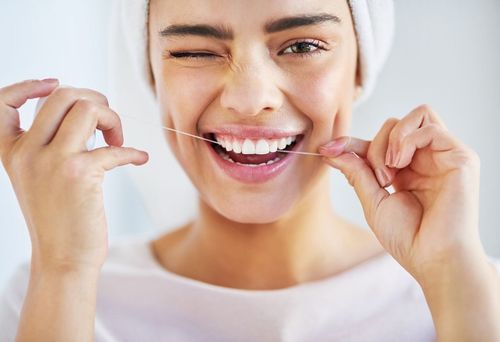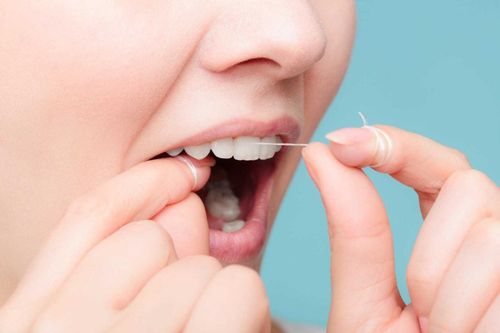This is an automatically translated article.
Flossing is a safe and effective "tool" to help remove plaque, bacteria on teeth. However, not everyone knows how to floss and how many times a day to floss. This article will guide you on how to use dental floss correctly to prevent dental diseases.
1. Why is it necessary to floss after brushing?
A toothbrush cannot reach the interdental area to effectively remove plaque in this area, but floss can.
Plaque - bacteria formed by sugar as well as food particles left in the mouth after eating. If these plaques are not removed, bacteria will consume them. The bacteria then secrete an acid that can erode tooth enamel and cause tooth decay.
In addition, long-term food plaque will harden, form tartar (or tartar), accumulate on the gum line and lead to gum diseases, especially gingivitis.
By brushing twice a day in combination with flossing, plaque and bacteria will be effectively removed.

Sử dụng chỉ nha khoa đúng phương pháp để phòng ngừa các bệnh lý răng miệng
2. When to floss?
This is a very interesting question from those who know this type of teeth cleaning method for the first time. According to the American Dental Association (ADA) recommendations, the best time to use floss is not fixed but depends on each person's conditions and time.
Some people will floss as a routine in the mornings after brushing their teeth, but there are also people who like to floss before going to bed or after eating. In general, in terms of flossing time, you can completely be proactive according to personal preferences and time.
However, according to a 2018 study, experts suggest you should floss before brushing. This study shows that flossing first helps to wash away bacteria and food debris stuck between teeth. Then, when brushing, the debris and plaque on the front and back of the teeth will be effectively cleaned.
At the same time, brushing after flossing, the concentration of fluoride from the toothpaste will tend to increase, thereby the ability to clean and reduce the risk of tooth decay is also higher.
3. How many times are dental floss used?
Asian people in general or Vietnamese people in particular have the habit of saving. This is a good virtue handed down from ancient times. However, this practice should not be applied to flossing.
A lot of people don't care how many times flossing can be used and they "save costs" for this method by reusing the floss 2-3 times. This is a mistake, not only causing dental problems but also facilitating the transmission of disease from one tooth to another or even from one person to another (if used together).
Therefore, you should only use dental floss once, each time you can save a short 30-40 cm. This helps the effect of the floss to be optimal, limiting dental diseases during use.

Rất nhiều người không quan tâm đến việc chỉ nha khoa dùng được mấy lần
4. How many times a day is it appropriate to use dental floss?
The problem of flossing how many times a day is also a common question related to flossing. According to recommendations from experts, you should not floss too many times. This will increase the risk of damaging teeth and gums, especially if you use it with force.
The use of dental floss can be more than 1 time / day but still must be in moderation (maximum 3 times / day).
5. How to use dental floss? Detailed instructions for flossing
How flossing is related to factors such as the user, type of floss... In which, there are 3 main groups as follows.
5.1. Floss without a handle Some floss, such as Oral-B, are silk floss and come in a roll-on box. To use this type of floss, you need to complete the following steps:
Use 30cm - 40cm only from the box and wrap it around two fingers so that the middle is about 4cm - 6cm long; Gently rub the middle thread up and down between the teeth; Bend the thread around the root area in an X shape and loop this thread down to the gum line; Repeat the above operations for many adjacent teeth, then use the clean thread to move to other interdental spaces; Use the same procedure to remove the floss from between the teeth; Perform for both teeth, 2 times each to ensure the most clean r8ng. 5.2. For the type with handle, how to use dental floss? Dental floss with a handle is used by many people, arranged in a box, each containing a small thread. This type of thread is convenient but relatively difficult to reach for molars.
To use this type of floss, you need:
Hold the handle of the floss, gently move the floss between the teeth, push up and down to pick up the plaque; Crease into each tooth to ensure the highest efficiency of plaque removal. Note, you should move this thread along the tissue around the gums to avoid causing bleeding gums. 5.3. How to use dental floss for people with braces? For people with braces, flossing is almost a task to ensure that their teeth are always clean. Flossing in this case is similar to using floss without a handle, but the operation needs to be gentler and slower. According to statistics, people with braces will take 3 times longer than normal to clean their entire teeth.
It can be said that the mouth is an important part that needs to be protected and cleaned regularly. Using dental floss will help you optimize this work besides brushing your teeth. Know how to floss how many times a day and how to use floss to help the process of use go smoothly and quickly.
Please dial HOTLINE for more information or register for an appointment HERE. Download MyVinmec app to make appointments faster and to manage your bookings easily.
Reference source: healthline.com












